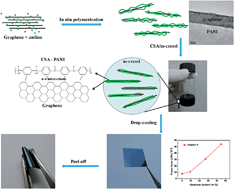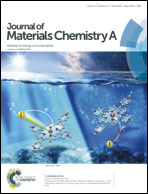PANI/graphene nanocomposite films with high thermoelectric properties by enhanced molecular ordering†
Abstract
Polyaniline (PANI)/graphene (GP) thermoelectric (TE) composite films were prepared by a combination of in situ polymerization and a solution process. It was found that there existed a large number of graphene–polyaniline nano-interfaces in the composite films with graphene nanoplates aligned in the PANI matrix in the direction parallel to the substrate. SEM, TEM, Raman, XPS and UV-Vis analyses indicated that polyaniline coated on the surface of graphene by the strong π–π conjugation interactions during in situ polymerization, and then the PANI molecular chains were expanded by the chemical interactions between polyaniline and solution. Both the in situ polymerization process and solution process contributed to the uniform dispersion of graphene in the PANI matrix, which not only increased the number of graphene–polyaniline nano-interfaces in the composite, but also strengthened the π–π conjugation interactions between graphene and polyaniline, resulting in more ordered regions forming in the composite films. Consequently, the Seebeck coefficient of the composite films was remarkably improved and higher than the values calculated based on the series-connected two-component mixture model. The optimal electrical conductivity and Seebeck coefficient of the composite with 48 wt% graphene reached 814 S cm−1 and 26 μV K−1, respectively, resulting in a maximum power factor of 55 μW m−1 K−2, which is the highest value among the reported polymer/graphene composite TE materials.


 Please wait while we load your content...
Please wait while we load your content...